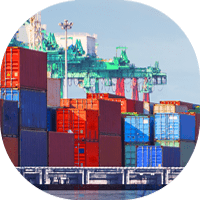Shipping to Costa Rica
At DFreight, we provide a wide range of business sea freight services for a variety of commodities, including foods, fruits, electronics, cosmetics, and furniture; offering transparent, effective, and reliable door-to-door cargo to Costa Rica from the UAE and vice versa. You can conduct business without being concerned about the challenges of shipping from the UAE to Costa Rica using our all-in-one digital freight solutions.
Our digital freight forwarding platform provides real-time monitoring of shipments, ensuring that you have complete visibility and control over your cargo. We offer end-to-end services tailored to your unique requirements, making shipping to and from Costa Rica a hassle-free experience. We help you ship business cargo to various cities in Costa Rica, including San Jose, Heredia, Cartago, etc. in the easiest, fastest, and safest way possible.
You can rely on DFreight to assist you with all of your international cargo shipping to Costa Rica thanks to our FCL and LCL shipment ocean freight cargo services. With the help of our digital freight platform, you may submit your inquiry right away and receive the best competitive prices for shipping your cargo to Costa Rica.
 Puerto Moin
Puerto Moin
 Abu Dhabi
Abu Dhabi

Caldera Port, located on the Gulf of Nicoya on Costa Rica’s Pacific Coastline, is the country’s premier port, handling more than half of the country’s foreign maritime traffic. The port city is a small town in Puntarenas province, adjacent to various tourist sites on the Nicoya peninsula. The port has an industrial facility for cargo ships and cruise liners. It primarily serves Puntarenas, Carthage, Heredia, Alajuela, and San Jose, and it maintains economic relations with the United States, African, and Asian countries. It is also a large container port with facilities for conventional cargo, RORO, and solid bulk shipments.

Puerto Limon, officially known as the Hernon Garron Salazar Terminal, is Costa Rica’s largest port and is located on the country’s northeast Caribbean coast. It is strategically located between the Panama Canal, the Gulf of Mexico, and the United States’ southern coast. A Free Trade Zone is nearby, as are facilities for small ship repair and maintenance, bunkering, and freshwater services. The port serves container ships, general cargo ships, and cruise ships. It has RORO capabilities but still loads and unloads freight with slings and pallets. The harbour can accommodate vessels with a LOA of 300 m, a beam of 40 m, and a maximum weight of 30,000 DWT.

North America
South America
Oceania
The top exports of Costa Rica are Medical Equipment, Bananas, Tropical Fruits, Orthopedic Appliances, and Other Edible Preparations, exporting mostly to United States , Netherlands, Belgium, Guatemala, and Panama.
The top imports of Costa Rica are Refined Petroleum, Medical Instruments, Broadcasting Equipment, Cars, and Integrated Circuits, importing mostly from United States, China, Mexico, Malaysia, and Guatemala.
Importing goods into Costa Rica requires compliance with specific rules and regulations. Importers must be registered with the Costa Rican Ministry of Finance and obtain an importer’s identification number. They must also adhere to customs documentation requirements. Certain goods may require additional permits, licenses, or certificates, such as agricultural products, pharmaceuticals, and chemicals. Import duties, taxes, and fees are typically assessed based on the value of the imported goods, and importers may need to engage the services of a customs broker to facilitate the customs clearance process. Compliance with labeling and packaging regulations, as well as sanitary and phytosanitary measures, is essential. It is crucial for importers to stay updated on any changes to import regulations to ensure smooth and legal importation of goods into Costa Rica.
All shipments in one place
We are with you until the end





